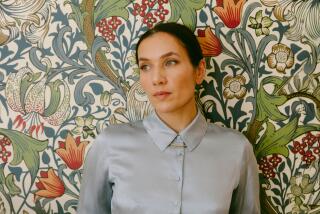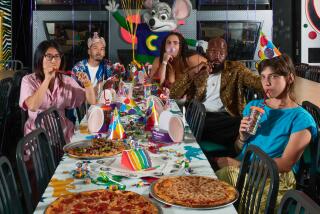The Age of Nip & Tuck : People have long gone under the knife to try to undo the effects of time and gravity. Typically, they were in their 50s and 60s. Now, thirtysomethings--and younger--are going for face lifts, collagen injections and cheek implants.
- Share via
Vanessa was tired of looking old and tired. Staring into the mirror at the dark bags under her eyes, she’d place her fingers over the half-moons and think, “I’d feel so much better if I didn’t have these.”
Finally, she did something about them. At 34, Vanessa, who requested anonymity, had the saggy skin tightened up.
Having plastic surgery at that age is hardly a shock. But having it at that age to look younger is a bit of one. Although surgeons note that fortysomethings and under aren’t exactly rushing en masse to demand appointments, facial rejuvenation surgery, as it’s known in the trade, is becoming increasingly popular with younger women and men.
“I’ve been in practice for 20 years,” says Dr. Dennis P. Thompson, president of the Los Angeles Society of Plastic Surgeons, “and I’m definitely seeing patients coming in at a younger age. The average patient when I started my practice 20 years ago was a woman in her late 50s or early 60s.”
Now, his typical facial rejuvenation candidate is 10 to 15 years younger. Still, such patients make up “probably less than 5% of the average plastic surgeon’s practice,” he says.
What do they want? Major and minor procedures, including face lifts, eye surgery to lift droopy lids or saggy under-eyes, liposuction to erase double chins, removal of fat from chubby cheeks, forehead lifts, collagen injections, cheek implants and chemical peels.
It seems as if our fascination with youth culture is growing, so much so that men and women still in or barely out of their 30s are looking for ways to put off the natural signs of aging. Plastic surgeons, aestheticians, patients and psychologists offer a variety of reasons for the downward curve, from cultural pressures to the greater acceptance of plastic surgery, to gaining an edge in the youth-tilted job market, to being more attractive date bait, to “Roseanne did it.”
“You have to ask the patient why they want to have the surgery,” Thompson says. “Somebody can have way-out reasons at 55 or 35. I could say, ‘I’ve got an operation that I think will improve your appearance, and there’s a good risk-benefit ratio.’ If someone who’s 35 comes to me and says, ‘Look at these heavy jowls,’ and I don’t see anything, I’ll tell them I don’t have an operation to prevent them.”
Not everyone who comes through a surgeon’s door merits surgery, doctors say, but age isn’t usually a disqualifying factor. More important is whether the surgeon believes he or she can markedly improve a patient’s appearance, and whether the patient has reasonable expectations about the outcome. One plastic surgeon said he had done an eye lift on an 18-year-old.
Dr. Stanley Frileck, a Brentwood-based plastic surgeon, says he sees more younger patients these days, including more men.
“Having plastic surgery earlier to forestall the need for (it) later on is something that makes sense to people,” he says. “The whole idea of rejuvenation surgery is to do it (at a time when) you actually need it, and . . . at a time (when) you tend to hold your appearance longer, while those around you are aging rapidly. So you look like you’ve made a pact with the devil. The people who are coming in have bought that rationale, understand it, agree with it, and that’s what they want to do.”
*
But having a face or eye lift at 37 doesn’t preclude the need for more nips and tucks down the road. The skin’s elasticity, as well such factors as sun exposure, determine how long a procedure lasts. As one surgeon put it: “Gravity’s working from the minute we take the last stitch out.”
Vanessa, who works as an office manager in Los Angeles, went to her surgeon to talk about having liposuction on her stomach. When she mentioned how much her eyes--a legacy from her father--bothered her, the doctor said he could excise the saggy skin.
“After I had it done (last June), I thought it was great, that I looked much, much younger,” she says. “For a long time (before the surgery), I’d look in the mirror and think, ‘I haven’t had enough sleep,’ and then I realized that after two years I still hadn’t had enough sleep.”
Staring into the mirror and seeing Mom or Dad staring back--complete with a deeply creased forehead or sagging eyelids--has driven more than a few people to the surgeon’s office.
“A lot of times people will have a family tree that will include a double chin,” says Dr. Malcolm Lesavoy, professor of plastic surgery at UCLA and chief of plastic and reconstructive surgery at Harbor-UCLA Medical Center. “Now, liposuction, in some younger patients who have resilient and elastic skin, can help very much by reducing the amount of fat (without) having to have a formal face lift.
“It’s not that people are having more sagging skin at an earlier age,” he adds, “but more patients at an earlier age are thinking about it. . . . There’s nothing whatsoever wrong with looking 40. I’m not so sure the bottom line is that (people who merit surgery and have it) will actually look younger. It’s not like they’re going to look 18. If they look tired and haggard, they’ll still look 40 (after surgery), but they’ll look better.”
Some of the younger rejuvenation patients simply consider age a disease they can prevent.
Decades ago, 40-year-olds were well entrenched in careers and family; today, they’re changing careers and starting families, says Wanda von Kleist, a Los Angeles- and Chicago-based psychologist and lecturer. Armed with copious information on the evils of cholesterol, fat, alcohol and tobacco, and the benefits of exercise, the baby boomers are light-years ahead of their parents in terms of self-improvement.
“When you look at the psychology of aging, the things that make people feel young are excitement for life, flexibility in the body and the mind, muscle strength, stamina, and feeling fit physically and mentally,” Von Kleist says. “But there are people who really buy into the idea that plastic surgery is the only way.”
*
Images of firm, poreless skin surround us. We spend billions on face creams, hair dye, exercise programs and surgery to roll back the clock. We revere actresses and models whose beauty is astounding, yet few of us stop to think what they may have done to achieve their looks.
“You can’t divorce yourself from the cultural influences,” Von Kleist says. “We don’t have many models of what a healthy, vibrant woman looks like at 30, 40, 50. We have some--Hillary Clinton, Jeane Kirkpatrick--but until you have other images of what vitality and beauty look like, it’s all in the physical realm of a 20-year-old.”
Von Kleist suggests a way to alter this perception: “We expand our idea of what beauty is, to include more dimensions until physical beauty is an aspect that has no more weight than any others. We need to develop our fullness as human beings, not just physical beings, and to glorify that to the exclusion of everything else.”
Gary, 40, is blunt when explaining the reason for his “lower two-thirds face lift. The doctor’s first question was, ‘What brings you here?’ and I said, ‘In a word, vanity.’ ”
After losing 45 pounds, the L.A.-based retail manager was unhappy with the double chin that stuck around. “I would have had it done five years ago, but I didn’t have the money then.
“I ran into a friend five days after the surgery and he said, ‘I can see you’ve got some swelling, but you look so incredible, you look so young!’ I did look older because of the fat that was hanging. I didn’t have wrinkles, but that look (of a double chin) does come from age.”
And how does he feel about aging?
“It’s something that’s always bothered me, the thought of getting older. There’s nothing you can do about it, and who wants the alternative? But if I can do something about it, I will.”
*
Many men and women in the entertainment industry apparently share that view; doctors say they account for much of the under-40 facial rejuvenation set. After all, this is a business in which aging can mean being relegated to unglamorous roles--or no roles at all.
Dana Delany knows the pressures well.
“If you live in L.A. long enough, you do think about plastic surgery--it’s almost impossible not to,” says the 36-year-old actress, who has not had her visage altered. (“I’m blessed with a young face.”)
“I’ve had many discussions with friends about it,” she says. “They say, ‘Should I do it?’ And I’ve said, ‘Should I do it?’ Something inside me always says ‘no.’ . . . The Puritan in me says, ‘God gave me this face, it’s what makes me unique.’ If I age, I’ll have earned every line.”
Delany says she even looks forward to growing older. “I’m dating a younger man right now, and it’s the first time in my life I’ve felt older. I’ve always been the younger one in a relationship. I like it. And I much prefer being in my 30s than in my 20s, and I think that my 40s are going to be even better.”
Others refuse to go gently into that good night.
Kathryn Klinger is president of Georgette Klinger, whose plush multipurpose beauty salon on Rodeo Drive caters to countless clients who have been lifted, tucked, liposucked and reshaped.
Although she’s not against plastic surgery, Klinger is alarmed by the recent trend of younger women going under the knife. “Nobody can look that bad in their late 30s or early 40s that they need a lift,” she says. “I think it comes from insecurity, and putting too much emphasis on wanting to be perfect. Your 40s should be your best time; we should have confidence in ourselves and enjoy life. But it’s contagious--one person in a group does it, it’s follow the leader.
“I don’t mind seeing some fine lines on myself,” the 43-year-old Klinger adds. “It doesn’t bother me.”
Would she at some point consider plastic surgery?
“Later, sure. But I don’t want to have three face lifts in my lifetime.”






